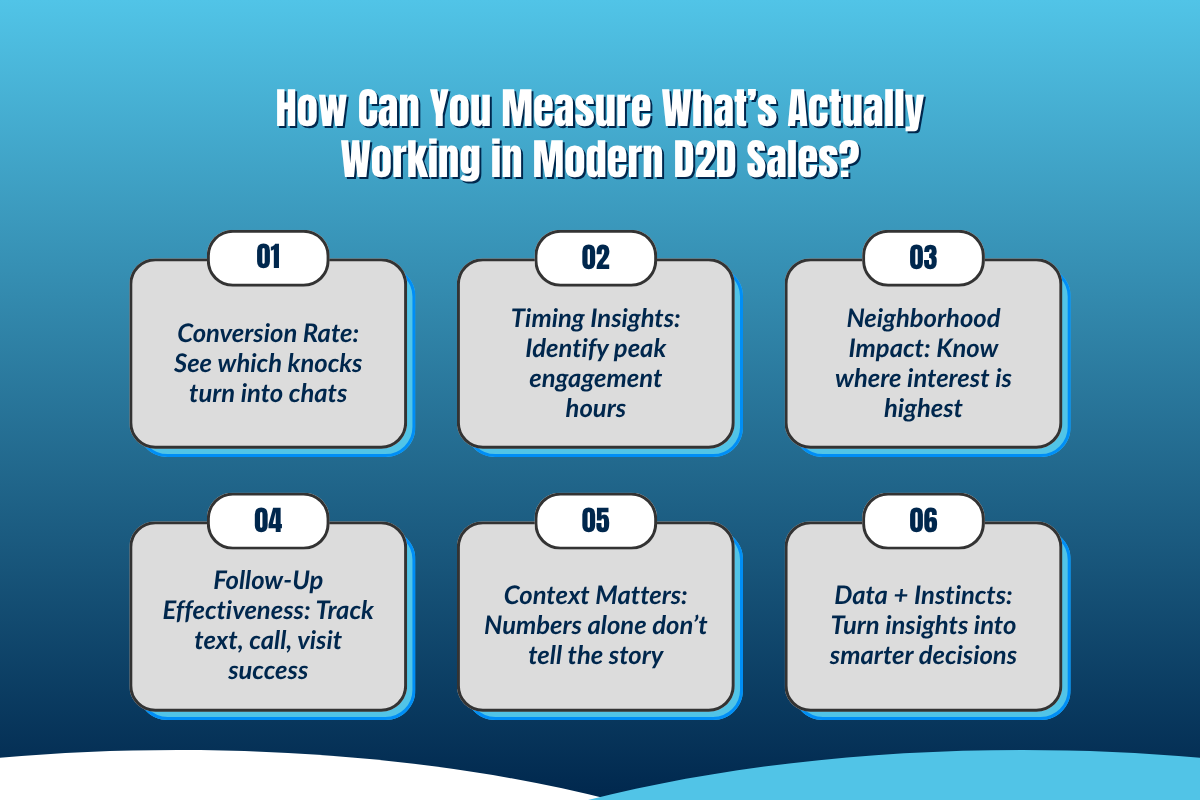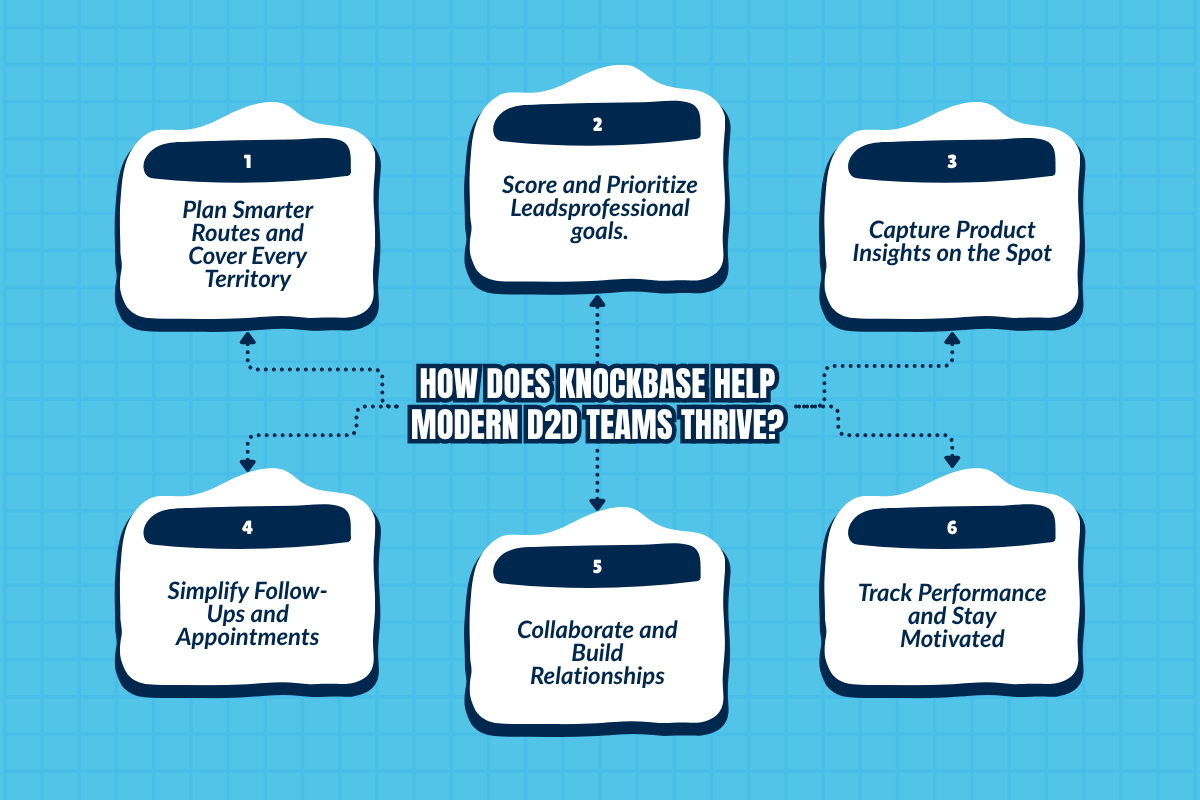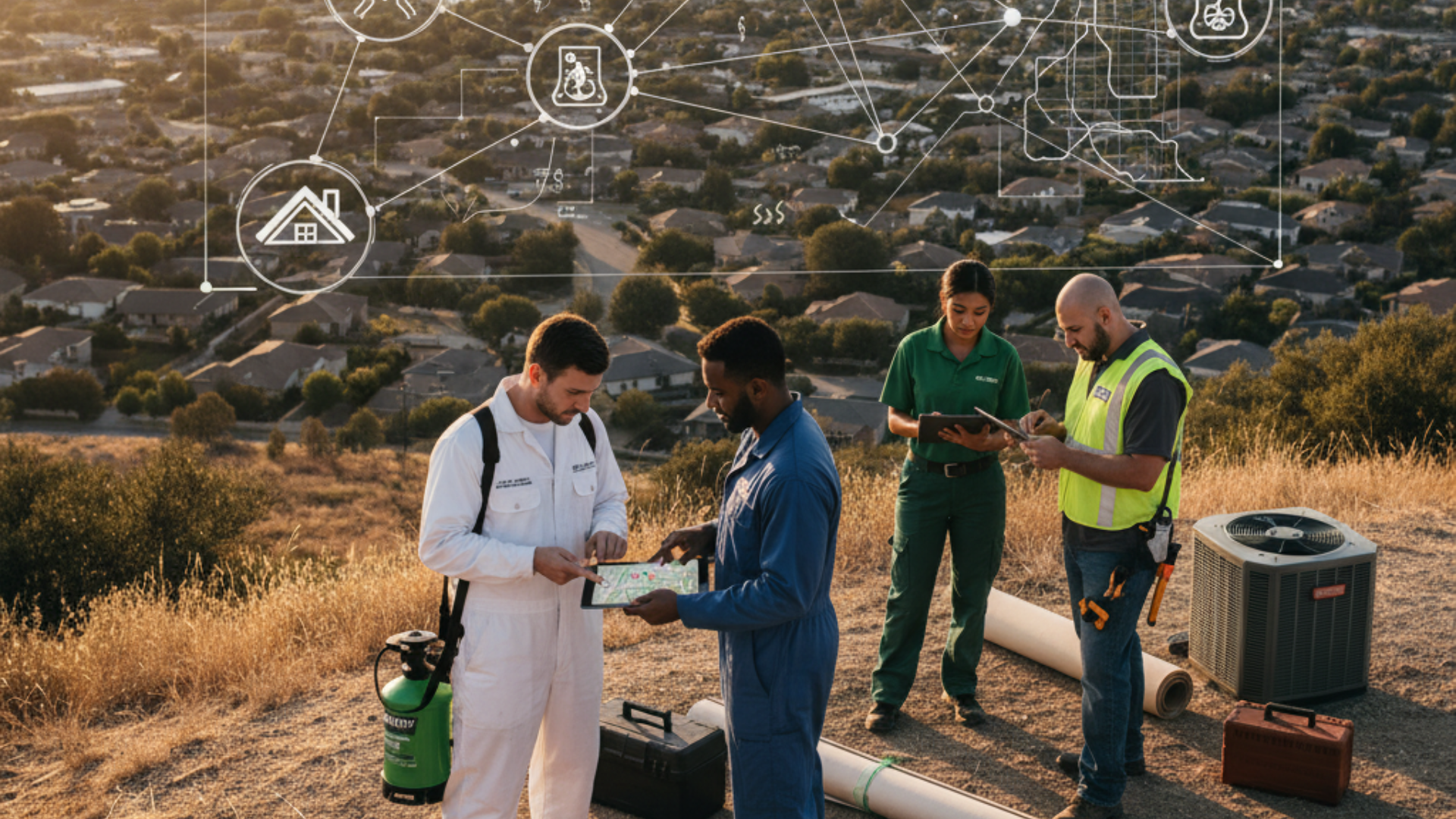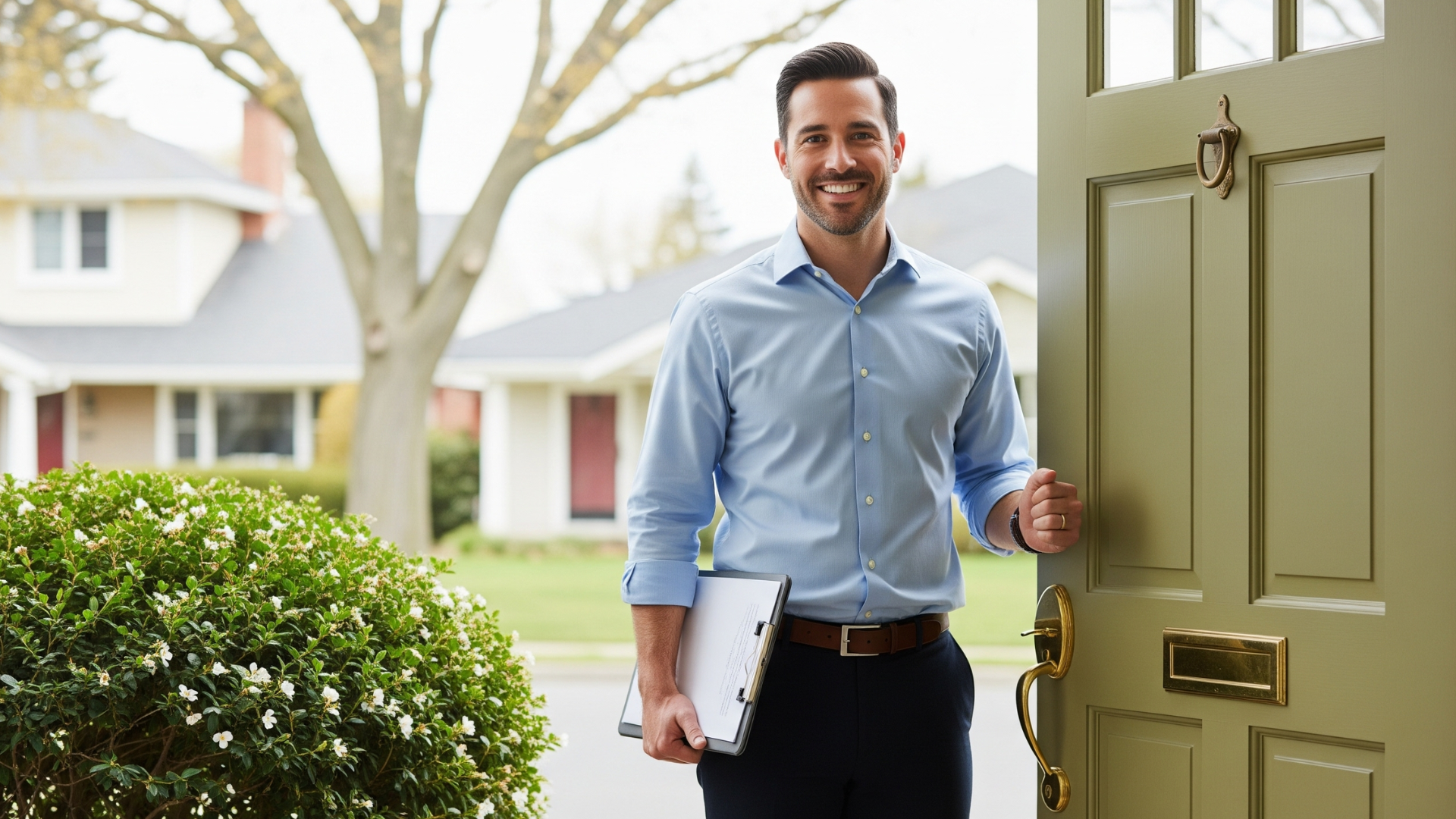Before diving ahead, let's first consider the situation from a customer's perspective when they encounter a salesperson, so let's envision this: You’re at home on a quiet afternoon when there’s a knock at the door, a scenario that affects many industries.
You peek through the window and see someone smiling confidently, wearing a branded shirt and holding a tablet.
What’s your first instinct, curiosity or caution?
That moment of hesitation is exactly what modern door salespeople face. In a world of digital ads and e-commerce, door-to-door sales (D2D sales) can seem old-fashioned.
Yet when done right, sales representatives remain one of the most personal and effective ways to connect with potential customers and expertly handle objections.
From understanding the prospect’s needs to leveraging data-driven insights, body language, sales techniques, and technology, the modern approach is about building trust, not just selling.
The Guide to Mastering Door-to-Door Sales in 2026 with Modern Tactics
Door-to-door selling has always relied on one thing technology can’t replace: human connection.
But for years, it suffered from pushy scripts, awkward pitches, and little regard for the person behind the door.
Today, the best D2D salespeople step into the prospect’s shoes, use body language and follow-up strategies, leverage data and technology, and excel at objection handling with empathy rather than pressure.
This guide is about rewriting that story. You’ll learn how 2026’s best D2D professionals use modern strategies, a human approach, data + tech, and ethics to sell smarter, build trust faster, and actually enjoy the process again with real success.
Key Takeaways
- Reaching out with genuine intent, timely reminders, and personalized communication helps prospects feel valued, transforming initial interest into lasting trust and eventual conversion.
- Using data wisely helps salespeople make smarter decisions while keeping the personal touch.
- Teams perform better when they feel supported, recognized, and connected. A motivated sales team thrives on appreciation and collaboration.
- Being honest and genuinely caring about customers’ needs is the modern edge in sales.
- Showing value and solving problems works better than simply selling products.
- Tools like Knockbase keep sales organized while helping reps stay human and meaningful in every conversation.
What Makes Door-to-Door Sales Still Relevant in 2026?
The question everyone asks: Why knock when you can click? Here’s the short answer: BECAUSE PEOPLE STILL BUY FROM PEOPLE!
Even in a hyper-digital era, the face-to-face approach delivers conversion rates that online campaigns can’t always match.
When done right, it doesn’t just sell a product; it builds trust, loyalty, and memory, along with the benefits of personal interaction.
According to the World Federation of Direct Selling Associations (WFDSA), the global direct selling market, along with improved sales performance, is projected to reach over $260 billion by 2029, growing steadily at around 6% CAGR. That’s not nostalgia, that’s momentum.
And within that market, home services, solar energy, and home improvement are leading the charge. These industries rely on personal connection, trust, and physical inspection, two things that thrive in D2D interactions.
What’s changed isn’t whether D2D works; it’s how you do it. The old playbook of knocking on every door in a zip code is dead.
Modern D2D is powered by data, empathy, and a deep understanding of your prospect’s world before you even take the first step toward their home.
Take a deeper look at: Why D2D Sales Still Outperform Digital Channels
Why People Still Don't Have Trust in Door-to-Door Sales?
Now, let’s be honest, the real problem here is that D2D reps have an image problem. Many people associate door sales with aggressive tactics, fake smiles, and pressure pitches. Those old-school approaches didn’t just fail to sell; they poisoned the well for everyone who came after.
That’s why people hesitate to open the door. It’s not about the product but more about trust.
This distrust grew because of:
- Misleading offers and unclear pricing.
- Reps who prioritized quotas over people.
- A lack of personalization, one pitch fits all.
The result? A lingering perception that D2D salespeople care more about the deal than the individual, leading to fewer satisfied customers.
But here’s the good news: today’s reps are changing that narrative.
Modern sales professionals build credibility before they even start their pitch, which also helps them expand their customer base.
They research the neighborhood, understand the local concerns, and show up as helpers, not hustlers. They talk like neighbors, not telemarketers.
Trust today isn’t built with a slick script; it’s built with transparency, empathy, and timing.
How Do You Identify and Understand the Right Prospects?
The best sales reps don’t knock on every door, but they knock on the right ones.
That starts by stepping into your prospect’s shoes: Who are they? What problems are they facing? How does your product or service make their life better or easier?
Modern D2D selling blends old-fashioned curiosity with new-age data. For example, sales teams can now gather information and access localized insights like average home age, energy usage, or family size, all within a few clicks.
Predictive analytics, when combined with technology, can identify which areas are most likely to benefit from solar panels or home upgrades. This means fewer wasted knocks, more meaningful conversations.
Here’s how today’s top reps qualify leads before the first hello:
- Define your ideal customer: Who benefits most from your offer? (e.g., homeowners, specific energy bills, or income brackets.)
- Use public data and mapping tools: Identify “hot zones” where your product solves a visible problem.
- Warm your territory: Use flyers, localized ads, or neighborhood posts before your visit. When they’ve already seen your name online, your knock feels familiar, not intrusive.
When you finally reach that door, you’re not a stranger; you’re a professional who has already done their homework.
How Can You Make a Strong First Impression at the Door?
In D2D, the first seven seconds decide everything. Your appearance, tone, and body language tell the prospect whether you’re there to help or to bother.
It’s not about wearing a suit or memorizing a perfect line; it’s about showing respect and confidence. Stand tall, maintain comfortable eye contact, and always start with permission:
> “Hey, I know I wasn’t expected, may I take a minute to share something that might help with your home energy costs?”
This small shift, asking instead of assuming, breaks the stereotype of intrusion.
A few underrated skills that separate pros from amateurs:
- Micro-expressions: A genuine smile and relaxed shoulders signal openness.
- Pacing: Match your prospect’s tone and tempo; don’t oversell excitement.
- Active listening: When they speak, pause. Don’t just wait for your turn.
Remember, your goal isn’t to deliver a perfect pitch; it’s to start a genuine conversation.
If they seem rushed, respect it. If they’re curious, explore further. The best D2D professionals in 2026 are masters of reading people.
Must read: The Psychology of Door Knocking: What Actually Works
What Does a Modern D2D Sales Pitch Look Like?
Let’s talk about the heart of it, your pitch. In 2026, D2D selling is less about persuading and more about guiding.
Gone are the days of rattling off product features or memorizing a “universal” script. Instead, modern reps focus on sales techniques, problems, stories, and proof.
Example:
Instead of saying, “We sell solar panels that reduce your bill,” you say,
> “Your neighbor two blocks over just cut their bill by 30% after installing the same system. Would you like to see what that could look like for your home?”
That’s relatable proof, not a cold claim.
Modern pitches also integrate technology subtly. A tablet demo, a short AR visualization, or an instant ROI calculator makes your conversation interactive, not intrusive.
A strong pitch in 2026 sounds like this:
- Start with a question that reveals a need.
- Share a short, real story.
- Show the benefit visually or numerically.
- Invite them to explore more, not commit now.
When objections arise (and they will), treat them like insights, not barriers.
> “I understand that concern; many homeowners felt the same before they saw the real savings data.”
This approach turns lost sales hesitation into curiosity. The best D2D closers in 2026 don’t force decisions. They leave prospects thinking, “That was worth my time.”
Why Does the Follow-Up Matter More Than the First Knock?
A great first impression opens the door, but a great follow-up keeps it open.
Most sales reps put all their energy into the initial pitch. They rehearse their greeting, adjust their posture, and even plan when to smile. But here’s the quiet truth: the sale rarely happens at the first door knock.
In fact, research shows that over 80% of sales close after the fifth follow-up, yet nearly half of salespeople give up after the first. That gap is where success or failure is decided.
Think about it, when someone opens their door, they’re interrupted. You’ve entered their world uninvited, and trust doesn’t happen in 30 seconds. The follow-up is where you show you listened, cared, and remembered.
A good follow-up is personal:
- Mention something you noticed: “I hope your dog, Bruno, is feeling better.”
- Send a quick text with useful info, not just a “checking in.”
- Leave a handwritten note if they weren’t home, thanking them for their time.
It’s not about chasing a sale. It’s about reminding them you’re human. That’s how you turn polite “maybes” into warm “let’s talk again.”
How Can You Measure What’s Actually Working in Modern D2D Sales?

Modern D2D sales thrive on data and reflection, not guesswork. In older models, salespeople would knock on every door and hope for the best. But in 2026, you don’t have to rely on chance; your phone can tell you what’s working.
Here’s what modern teams track:
- Conversion ratios: How many knocks lead to meaningful conversations?
- Time of day effectiveness: When are people most receptive?
- Neighborhood engagement: Which locations show higher interest?
- Follow-up outcomes: Which types of follow-ups (text, visit, call) close faster?
But numbers alone aren’t enough; context matters.
Maybe a neighborhood with fewer conversions has higher long-term potential because people need more education before they commit. Or perhaps you’re more persuasive in the evenings than in the mornings.
The insight lies not in the data itself, but in how you read it. Data doesn’t replace experience; it amplifies it. When teams use data to refine their instincts, every step becomes smarter.
Must read: How Top D2D Experts Use Tech to Maximize Route Efficiency
What Keeps D2D Teams Motivated and Confident?
D2D sales can be emotionally draining for any marketing team. Rejection, long hours, and unpredictable responses take a toll. But the best teams in 2026 aren’t powered by pressure; they’re powered by purpose.
Here’s how leaders keep their teams motivated:
- They redefine success. A “no” isn’t a failure but data. It teaches you what didn’t click and how to refine your approach.
- They celebrate small wins. Every pleasant chat, every genuine smile, every good follow-up counts.
- They focus on community. Reps who feel connected to each other stay resilient. Sharing stories of rejection and success keeps morale high.
The mindset shift is crucial:
- Don’t see yourself as “selling.”
- See yourself as educating and guiding people to solutions that truly help them.
- That’s what today’s homeowners respond to: confidence rooted in sincerity.
How Does Ethics Redefine D2D Success?
There’s a reason many people still roll their eyes at the phrase “door-to-door sales.” Decades of pushy tactics, sales tips, half-truths, and forced closings gave the field a bad reputation.
But 2026 is rewriting that story. Today’s successful reps sell with integrity and transparency, because customers can verify everything you say within seconds.
Ethics in D2D means:
- Being honest about what your product can realistically do.
- Explaining costs, warranties, and limitations clearly.
- Respecting privacy, never pushing when someone says no.
When people sense honesty, they relax, they listen. They even refer you to others. The irony? The more transparent you are, the faster trust and sales grow.
How Is D2D Transforming in Home Improvement and Solar?
Few industries have benefited from the D2D revival as much as home improvement and solar.
These are personal, high-involvement decisions, and people prefer talking about them in person. They want to see who they’re trusting with their home.
Here’s what’s changed:
- Consultative Selling: Instead of “offering panels,” reps guide homeowners through customized savings estimates or energy comparisons.
- Visual Aids: Portable tablets, roof-mapping tools, and AR demos make abstract ideas tangible.
- Education Over Persuasion: People no longer want a pitch; they want a plan.
When a rep helps a homeowner visualize sunlight patterns, cost recovery, or environmental impact, it doesn’t feel like a sale; it feels like a partnership. That’s the future of solar D2D: empathy and expertise walking hand-in-hand.
What Common Mistakes Should You Avoid in 2026?
Even the best reps fall into old habits. Here’s what to steer clear of:
1. Talking more than listening
This is the most common mistake that most reps make. Remember: Your goal isn’t to dominate the conversation; it’s to discover needs.
2. Ignoring digital touchpoints
Door-to-door doesn’t end at the doorstep. A quick door sales tips follow-up email, link to a savings calculator, or WhatsApp message makes you memorable, unlike a rigid sales script.
3. Using outdated scripts
If your pitch sounds rehearsed or robotic, people tune out. Speak naturally, like you’re helping, not selling.
4. Skipping research
Don’t knock blind. Study your target neighborhoods and use data to choose timing, tone, and approach.
5. Overpromising
Honesty might feel slower, but it always leads to stronger referrals and fewer cancellations.
Avoiding these mistakes is how ordinary reps turn into trusted professionals.
What’s Next for Door-to-Door Sales?
The future isn’t about knocking on more effective doors but more about knocking better.
As technology becomes more personal, D2D will blend physical presence with digital intelligence. Expect to see:
- AI-assisted route planning that shows the most receptive homes.
- Emotion-recognition software that helps reps read reactions better.
- Integrated CRM systems that automate follow-ups seamlessly.
But none of this replaces what makes D2D magical, the human connection. Technology can enhance your timing, tone, and data, but your handshake, your smile, and your ability to listen are irreplaceable.
How Does Knockbase Help Modern D2D Teams Thrive?

Technology should make selling easier, not more complicated. That’s where Knockbase comes in. It’s designed to help door-to-door sales teams stay organized, work smarter, and keep the human connection at the center of every visit.
Here’s how Knockbase makes a difference:
1. Plan Smarter Routes and Cover Every Territory
With geo-tagging and territory management, reps know exactly which areas to visit. No overlaps, no missed doors. This helps focus on the right decision makers and ensures every visit counts.
2. Score and Prioritize Leads
Knockbase automatically ranks prospects, so reps spend time on the highest-potential homes. This means more meaningful conversations and better chances of a successful purchase.
3. Capture Product Insights on the Spot
Custom forms and surveys let reps log the product inside every home, collect homeowner preferences, and record feedback instantly. No details are lost, and every conversation is informed.
4. Simplify Follow-Ups and Appointments
Automated reminders and in-app scheduling make follow-ups effortless. Reps can nurture leads efficiently and turn interest into actual purchases without forgetting a single step.
5. Collaborate and Build Relationships
Team collaboration tools allow reps to share notes, assign tasks, and stay connected. This strengthens communication, ensures everyone is aligned, and helps build relationships that last.
6. Track Performance and Stay Motivated
Live dashboards and gamified leaderboards show progress in real-time. Reps see how they are performing, celebrate wins, and stay motivated to achieve door-to-door sales success.
With Knockbase, every knock is intentional, every conversation informed, and every rep supported. It’s not just about selling more; it’s about selling better, connecting meaningfully with homeowners, and helping companies turn each visit into a genuine opportunity to sell door to door.
What Can You Take Away from All This?
Door-to-door sales aren’t a thing of the past; they’re the most human form of marketing we have left. It’s not about “selling” anymore. It’s about connecting, understanding, and helping. When you mix technology, data, and heart, you don’t just get more sales, you build real relationships.
So next time you knock, remember: People don’t buy products. They buy people who make them feel understood, especially those who visit customers with care.
About Knockbase
Knockbase is an all-in-one platform built for modern D2D sales teams.
From lead tracking and route optimization to live performance insights and follow-up reminders, Knockbase helps sales professionals work smarter, sell ethically, and build trust door by door.
Turn data into action and every potential door into a sale. Schedule your Knockbase demo now!
FAQs
1. Are door-to-door sales still effective in 2026?
Yes. When powered by data, empathy, and technology, door-to-door sales remain one of the most cost-effective and trust-based ways to convert qualified leads in local markets.
2. What industries benefit most from D2D selling?
Solar, home security, home improvement, and pest control continue to see exceptional ROI from personalized, in-person sales approaches.
3. What makes Knockbase different?
Unlike traditional CRMs, Knockbase focuses on human connection; it uses technology to simplify the sales process for various fields, including security systems, without losing authenticity or empathy.
4. How can I get started with D2D sales?
Start by understanding your target audience, mastering your product knowledge, and using modern data-driven tools like Knockbase to organize, measure, and grow your efforts effectively.













